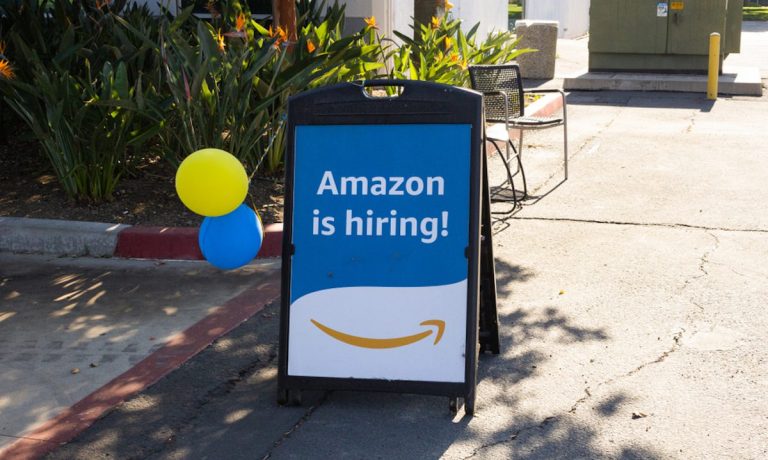
Amazon has now struggled to meet earnings expectations for two quarters in a row as eCommerce sales growth slows and the labor shortage adds additional costs, undermining the investments the Seattle-based company has made to create an efficient logistics network.
Chief Financial Officer Brian Olsavsky told analysts on Thursday (Oct. 28) that lost productivity because of the labor shortage on top of inflation added $2 billion of operating costs in the third quarter, particularly in August and September. In the fourth quarter, these costs will likely be close to $4 billion.
“In Q3, labor became our primary capacity constraint, not storage space or fulfillment capacity,” the CFO said, noting that Amazon has on several occasions been forced to reroute inventory to warehouses that had enough workers to receive the products, resulting in “less optimal placement, which leads to longer and more expensive transportation routes.”
Read more: Amazon Warns of Billions in Additional Costs to Meet Holiday Demand
Walmart is not scheduled to release its earnings until Nov. 16, but Amazon’s struggles likely don’t bode well for what’s in store when Arkansas-based executives make their report. Walmart and Amazon have both been on hiring frenzies in the past several months to prepare for the holiday shopping season, and the fact that Amazon, despite its might, is unable to find enough workers is, as Olsavsky said, “not welcome.”
And as holiday shopping gets into full swing, Amazon may have a leg up on its box store rival. PYMNTS research, conducted in collaboration with Kount, found that 87% of consumers plan to shop online this holiday season, a 10% jump from last year, despite many consumers returning to reopened stores. Amazon, according to PYMNTS’ proprietary data, has nearly 50% of the eCommerce market and over 9% of consumers’ overall retail spend, locking the company in a dead heat with rival Walmart.
Related news: Holiday Shopping Outlook Suggests ‘Amazon Christmas’ May Be Underway
Olsavsky said Amazon does not intend to pass on any of its increased costs to third-party sellers or consumers, noting that wouldn’t fit with the company’s “customer-centric” mindset.
“We see ourselves as the shock absorber, absorbing a lot of the costs so that the customer is not impacted and sellers are not impacted,” Olsavsky said.
Walmart Upgrades Gap Home
Walmart, meanwhile, is expanding its partnership with Gap to add furniture to the Gap Home line, complementing the brand’s home furnishings currently sold on Walmart.com.
Gap Home Furniture will consist of more than 150 items, including couches, ottomans, headboards and rugs, among other products in contemporary styles. The furniture is currently available on Walmart.com.
Anthony Soohoo, executive vice president of home at Walmart U.S., said in a blog post that the company has received “fantastic feedback” on the 400 home décor, tabletop, bedding and bath items that make up the inaugural Gap Home collection, which launched in June. He added that the furniture line will help customers “ultimately pull their whole space together.”
Soohoo said a capsule collection of Gap Home bedding styles will also soon be available in select stores.
“Our customers have been spending more time in — and investing more in — their homes,” Soohoo said. “This nesting trend is one we anticipate continuing, and we are committed to offering Walmart shoppers a wide variety of accessible, on-trend styles so that a beautiful home is possible for everyone.”
For Walmart, the partnership with Gap is an attempt to expand its share of the furniture and home furnishings market and claw back its lead in the category over Amazon. Walmart has had approximately 10% of home furnishing sales each year since 2017, while Amazon has seen its share of the market grow by at least two percentage points annually over the same time period, including a 4% jump in 2020.
Source: PYMNTS data
Additionally, the first half of the year saw Walmart’s furniture and home furnishings sales dip below 9%, likely an unwelcome sign for executives who are doing everything they can to keep Amazon at bay.
To be sure, furniture and home furnishings likely aren’t going to make or break the race to be the top retailer in the U.S. For Amazon, furniture and home furnishings make up about 9.7% of its total retail sales; for Walmart, the category accounts for about 6.6% of sales.
Related news: Home Furnishings Remain Sore Spot for Walmart, Despite Gap Collaboration
Going After Groceries
Walmart also took a shot at Amazon this week with a cash-back promotion for new Walmart+ subscriptions, offering a $9.95 rebate to anyone who signed up on Monday — the same day that Amazon’s grocery delivery service from Whole Foods instituted a delivery fee of $9.95.
Food and beverage is a critical category for Walmart, accounting for 56% of all sales made in the second quarter; for Amazon, grocery made up just over 5% of sales.
Source: PYMNTS data
See also: Amazon’s Food Fight Fails to Minimize Walmart’s 10-to-1 Lead
Amazon has been ramping up its efforts in the space, opening several Amazon Fresh locations across the U.S. and adding a full-scale grocery store in the Seattle area earlier this year. The company also recently said it would introduce Just Walk Out technology at two new Whole Foods locations slated to open next year, expanding the use of the technology and potentially bringing more people into stores at a time when delivery and curbside pickup remain customers’ preferred shopping methods.
And looking just at digital grocery sales, Amazon appears to have a growing advantage. In the second quarter of 2020, the company saw approximately 28% of eCommerce food and beverage purchases; in the same period this year, Amazon has a 33% share.